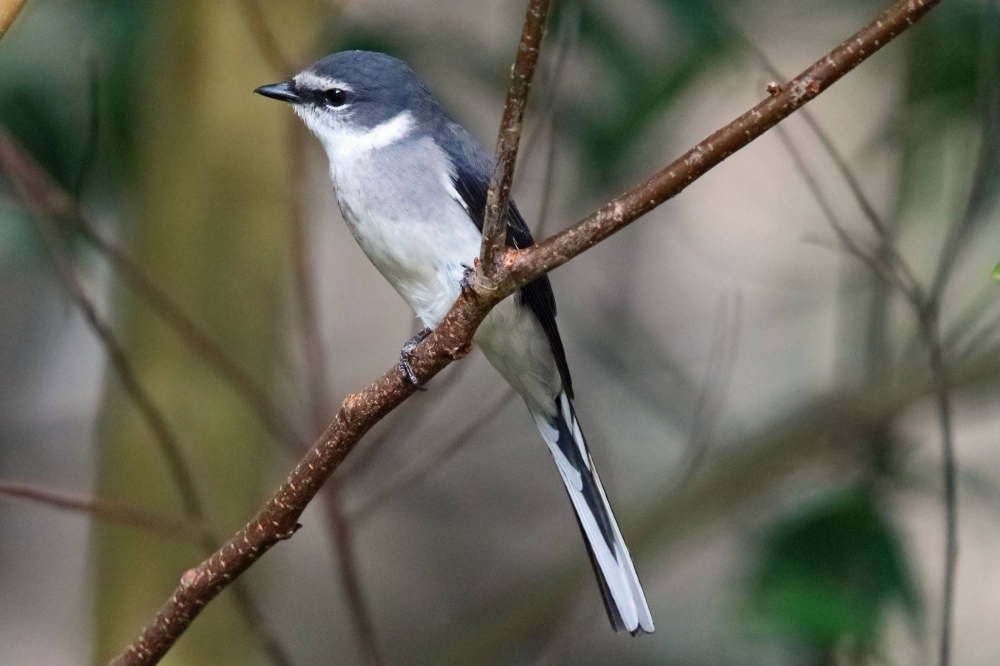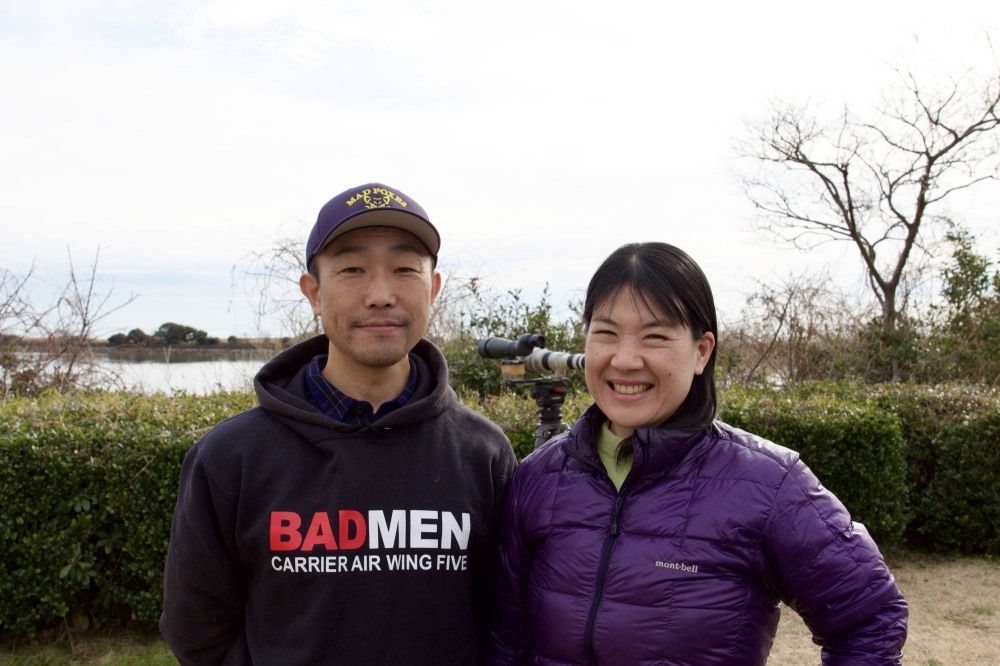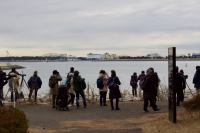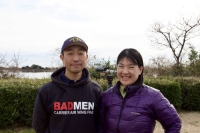“A murder!” Ryouji Shimada exclaims.
We’re in Kasai Rinkai Park in Tokyo’s Edogawa Ward on a chilly Sunday morning. I rush over, binoculars swinging around my neck, my ill-chosen heavy leather shoes clumping on the ground. As Shimada picks up a feather from an array of them scattered messily across the grass, he shows me how the quill hasn’t broken, so the culprit is unlikely to be a tanuki. Instead, it’s more likely to be another bird.
The avian assassin leaves behind a brutal mess of plucked feathers but no body, but that is a mystery for another day.
Bird-watching — or birding as some prefer, as it also encompasses listening to birds — is more thrilling and more like detective work than one might initially guess. Not just a social activity, it increasingly plays a critical role in mapping bird behaviors and paving the way for policy and conservation initiatives.
“By watching the bird and imagining their life and background, it becomes an even richer experience and you notice changes in the bird's surroundings — ‘Why has the number of birds I used to see decreased, and why has there (been an) increase in birds I didn't see before?’” Shimada says.
You can pick out the members of the Wild Bird Society of Japan right away by their socks, keychains and badges adorned with the animal. Bird-watchers also tend to carry a checklist of birds for recording their sightings. At the end of each expedition, notes are swapped and then compiled into a magazine detailing the patterns of different types of birds, complete with intricate hand-drawn illustrations.
With researchers in short supply, according to the Japan Bird Research Association, hobbyists play a critical role in gathering valuable data.
Joining the group, it doesn’t take long to be swept up into the rhythm of regularly raising binoculars to your face and tilting your chin to search the skies. A sudden sighting of an uncommon bird sends a rush of enthusiasm through the group — the rarer birds are spoken about almost like celebrities.
Once you start noticing birds, it's like following a code, but hidden in plain sight. Their sudden movements catch your eye and their distinctive calls grow prominent, rising above the other background sounds.
As I peer through binoculars at the vivid, delicate bodies of the birds, it is like putting on glasses after a prolonged period of shortsightedness and for the first time really seeing something. One bird has feathers that form patterns like hearts, some are orange like the gates of Japanese shrines, and even the most plain bodies are exquisitely built, twitching like delicate mechanical creatures.
“My friend says that watching the birds is like watching the world beyond,” says Shimada.
Backyards and beyond
Like many people overseas, Japanese have long been interested in our avian neighbors: Some of the earliest haiku describe bird calls, while the creatures are also nestled in ancient Ainu mythology, with some considered to possess the power to bewitch people with their calls.
In Japan, bird-keeping became a prominent trend and status symbol during the Edo Period (1603-1868), a time when songbird competitions were in vogue. People trained birds to sing, and some districts were famous for producing birds with beautiful voices, according to researcher Sachiko Koyama at the Indiana University School of Medicine. But it took time for bird-keeping to give way to bird-watching.
A turning point for Japan came in the first half of the 20th century, when Godo Nakanishi, a wild bird researcher and poet, pushed for bird observation rather than trapping and killing — he is even credited for introducing the word yachō (wild bird) into Japanese.
In 1934, Nakanishi founded The Wild Bird Society of Japan with the slogan “Let wild birds be wild.” Today, it has over 50,000 members and 86 chapters, with research being one of its focal points.
Indeed, scientists’ reliance on citizen-sourced data means bird-watching is an important tool for conservation efforts.
In recent years, a series of new apps have sprung up, enabling bird-watchers around the world to easily gather valuable scientific data from backyards, mountaintops and beyond, painting a fuller picture of the environmental factors affecting birds’ migration habits and populations.
Bird identification apps such as Merlin Bird ID and eBird, both created by the Cornell Lab of Ornithology, grew more popular during the pandemic as the sounds of city life temporarily receded and the number of bird-watchers rose.
Jenna Curtis, one of the project leaders for eBird, says that bird-watching data can be used to develop “powerful conservation resources, like weekly maps of bird abundance on continental scales.” But these are “data hungry — meaning they require lots and lots of data points in order to work. Creating resources at this scale and level of detail simply wouldn’t be possible without observations shared by birders,” she says.
“Together, the birding community can gather more data on birds, from more locations, than any scientist or research team could hope to accomplish on their own,” Curtis says. Data collected by birders and submitted to eBird makes up about half of all biodiversity data in the Global Biodiversity Information Facility, the world’s largest open-access biodiversity data infrastructure.
Hiroko Okamoto, a member of the Wild Bird Society of Japan, says that Japanese bird-watchers have had a tendency to record their sightings in field notebooks and keep this to themselves.
“Those recordings could be critical information to understand the birds of Japan, for example knowing distribution or population change of each species,” Okamoto says, noting that localized apps such as eBird Japan allow users to input their data and therefore make it globally valuable.
Vidya Padmakumar, a Canada-based biologist and bird expert, knows just how valuable bird-watching data can be in illustrating environmental changes.
“Changes in bird populations, migration patterns and breeding behaviors can signal broader ecological shifts, including the impacts of climate change, habitat loss and pollution,” Padmakumar says, noting birders often record such observations, allowing scientists to understand the impact.
At the same time, the volume of citizen data available via apps has created complications of its own, with scientists having to distinguish between patterns that are the result of richer data and those that are a result of changes in climate, pollution and habitation.
While Shimada has observed changes in migration patterns, he thinks it’s dangerous to conclude that changes are a direct result of global warming, as the development and disruption of natural habitats can also be to blame. More complete data would help to paint a clearer picture, he says.
Breaking stereotypes
While bird-watching might have been historically associated with the elderly or overly fastidious, in recent years it has become more “cool” and drifted into the mainstream.
High-profile bird-watchers such as writers Margaret Atwood and Jonathan Franzen and musicians Jarvis Cocker and Paul McCartney, who have featured birdsong in both of their work, have spoken about their love of the hobby. At the same time, there has been a push toward more inclusive bird-watching through movements such as Flock Together, a “bird-watching collective for people of color.” Meanwhile, subcultures such as “birdpunk,” which sees tattooed punk fans apply the genre’s DIY ethos to bird-watching, have also cropped up.
In part, this may be due to the fact that bird-watching can be affordable and accessible regardless of socioeconomic position.
“No special qualifications are required, all you need is a little bit of curiosity,” Shimada says of the necessary credentials.
Padmakumar has observed a shift in the culture of bird-watching over time, she says, with a rising number of women and younger participants taking part, “reflecting a broader shift toward accessibility and the breaking down of stereotypes associated with the activity.”
It’s important, too, for bird-watching to be more accessible — not just for the gathering of scientific data, but because birds make us happier and more invested in our natural environment, researchers have found.
And according to a 2020 study, it is not just bird-watching that is good for us — “bird species richness is positively associated with life-satisfaction.”
“We found a relatively strong relationship, indicating that the effect of bird species richness on life-satisfaction may be of similar magnitude to that of income. ... Based on these results, this study argues that management actions for the protection of birds and the landscapes that support them would benefit humans,” the researchers wrote.
Shimada knows firsthand just how positive the effects of bird-watching can be.
“Ten years ago, my world was only the size of my 17-inch monitor at work. When I started bird-watching, my world became a completely different size,” he says, describing the sense of scale that comes from the engagement with birds’ migratory journeys. “My mind freely travels from Wrangel Island in Siberia to Auckland in New Zealand.”
But while bird-watching has undoubtedly expanded Shimada’s world and social group, he also feels concerned about bigger issues affecting the birds that make him happy.
“Watching birds also makes me anxious. When no winter birds come in December, I worry that some serious and irreversible change has occurred in their environment,” he says, noting that he sees himself as part of a larger bird-watching culture that deeply cares about the environment.
“I would like to pay my respects to my seniors who left behind a place where these birds can live in peace, and to pass the relay baton to my juniors,” he says, noting that by actively participating in The Wild Bird Society of Japan, he hopes to have an impact.
“Of course, I know that's only one small action for me, but I (hope such actions) will be one giant leap for next generations.”












